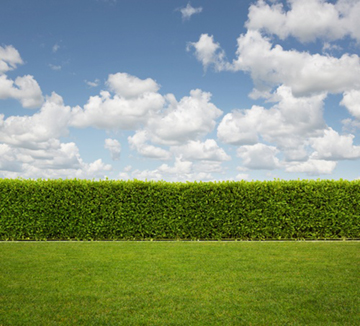Creating privacy is often a priority for many homeowners. Installing a fence is a common option for creating privacy, but it isn’t right in every circumstance. For those looking to create privacy without putting up a fence, growing a privacy hedge could be the best solution. Here’s what you need to know to create a beautiful living fence that will provide the privacy you’re looking for and last for years to come.
Benefits of a privacy hedge
Growing a living fence has many benefits, including:
- Obstructing an unpleasant view and creating a more beautiful one.
- Providing a barrier for noise.
- Providing privacy from neighbors.
- Protecting against wind.
- Combating road pollution.
Choose plant type
When growing a privacy hedge, you need to determine what kind of plant will best suit your needs. You basically have two choices:
- Deciduous – A deciduous hedge will lose its leaves in winter, which will provide less privacy. However, deciduous hedges will often produce beautiful flowers in spring and summer and attractive fall foliage.
- Evergreen – An evergreen hedge will provide privacy throughout the entire year, but it won’t provide the same amount of visual interest in spring, summer, and fall that a deciduous hedge will.
Understand space requirements
Not all hedges can be grown in all spaces. In order to choose the best type of privacy hedge for your property, determine how much space you have. How tall can the hedge grow, and do you want it to provide privacy on a second story? How wide is the space you have? If you don’t have much width, you will need to choose narrow, compact hedges that won’t overgrow the space. Good choices for narrow spaces include boxwood and arborvitae.
Mark the area
Once you’ve determined what to plant based on your needs, it’s time to mark the planting area. Use sticks to mark each end of the area and tie a string between them. This will help to ensure that you are planting the hedge straight. Determine how far apart each plant needs to be, and tie sprinkler flags at each point along the string.
Planting the hedge
Once you’ve marked the planting area, you will dig a trench for your hedge. The trench should be two-to-three times wider than the root ball of the largest plant. The depth of the trench should be two inches less than the depth of the largest root ball. Place one plant at each sprinkler flag. Mix the soil you’ve dug out of the trench with compost in a two-to-one ratio, and fill the trench back up level with the surrounding area. Create a dam around each plant that is slightly wider than the root ball and thoroughly water the plant. Make sure to water the plant once a week until it is firmly established.
Training the hedge
In order to create a full and lush hedge, you will need to train the shrubs or trees you’ve planted. Give the plants one or two seasons to establish themselves. Then, each year cut new shoots to half their length.



